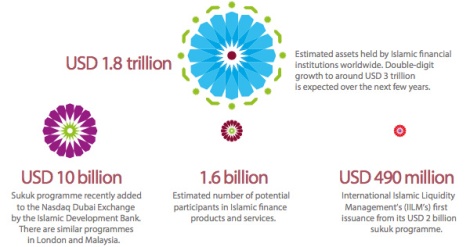Islamic finance has been growing rapidly over the past decades, reaching $1.8 trillion in 2014 and is expected to exceed $3 trillion by 2018. In a recent article by BearingPoint Institute, the consulting firm considers the differences between the partnership practice of Islamic banking and the practice of interest. The firm also explores the wider challenges faced by both Islamic and western banking institutions as the practice of Islamic banking further expands to meet the needs of up to 1.6 billion potential participants in Islamic financial products and services.
How finance works is somewhat rigidly understood within much of the Western financial world, and while companies are developing potentially disruptive new financial products, as well as creating new platforms on which to access funding, the fundamentals remain relatively similar. Islamic states, such as Saudi Arabia, Qatar and Malaysia, also practice a form of finance, called Islamic finance, which eschews one of Western finances fundamental concepts: interest.
Islamic finance
Interest has the potential to be leveraged punitively, where the need of the beneficiary is taken advantage of by those with means. To prohibit less than ethical practices within finance, Islamic finance seeks to share risk/reward as a key tenet. Banks are required to build a clear understanding of what is being financed, with the agreement between parties more akin to a partnership. The principles of Islamic banking come from the Sharia law that prohibits usury, uncertainty and speculation; rather it requires transparency and necessitates physical presence for money transfers.

As its practices are firmly rooted in ethical constraints on practices, with profit not an above all but state imposition, Islamic banking has quietly enjoyed a growing market share in Saudi Arabia, Qatar and Malaysia, recently reaching 50%. Some of the region’s most powerful banking institutions are engaged in the practice, including Al Rahji Bank and Bank Al Jazira in Saudi Arabia, as well as the Kuwait Finance House.
Today Islamic banking is a $1.8 trillion dollar financial structure, with a large number of different segments being served by Islamic banking institutions. The baking practice is growing rapidly, with double digits, and is expected to be worth up to $3 trillion by 2018.
One of the main financial instruments in Islamic banking is sukuk, which is roughly equivalent to bonds. Through entering into partnerships with small players, Islamic banks provide a different funding source than government finances, which accounts for 62% of some markets. Furthermore, unlike conventional bonds, sukuk grants the investor a share of an asset, along with cash and risk. The largest part of the total bonds issued in the market has been provided to financial services at 26%, followed by energy & utilities at 25%. Transport comes in at 19% followed by real estate at 8%.
Ethical partnerships
According to BearingPoint, a number of challenges face the form of banking. The main challenge relates to staying within international and national regulations while at the same time making sure that providers keep their reputations and remain within the spirit and the letter of the practice. Finding relevant skills also is an issue for institutions, at both the level of principles and operational practice required in meeting face to face and upholding strong bonds.
Western financial institutions seeking to enter the Islamic financial market face considerable hurdles. According to the researchers, a lack of cultural awareness and a fundamentally wrong intention behind the practice are possible barriers. One way to enter the relevant markets is to create subsidiaries that are their own brands, like ‘Amanah’ created by the HSBC group. As the practice is expanding into new areas, the risk of Western business not fully understanding the way of engaging with partners makes it considerably more difficult to reach out to the Middle East, Africa and Far Eastern countries, such as Malaysia and Indonesia. Banks in these regions are increasingly likely to come across organisations for whom it has a place – customers, partners, suppliers, and governmental and non-governmental organisations.
*This article was originally published on consultancy.uk on 13 August 2015. Read the original article here.
